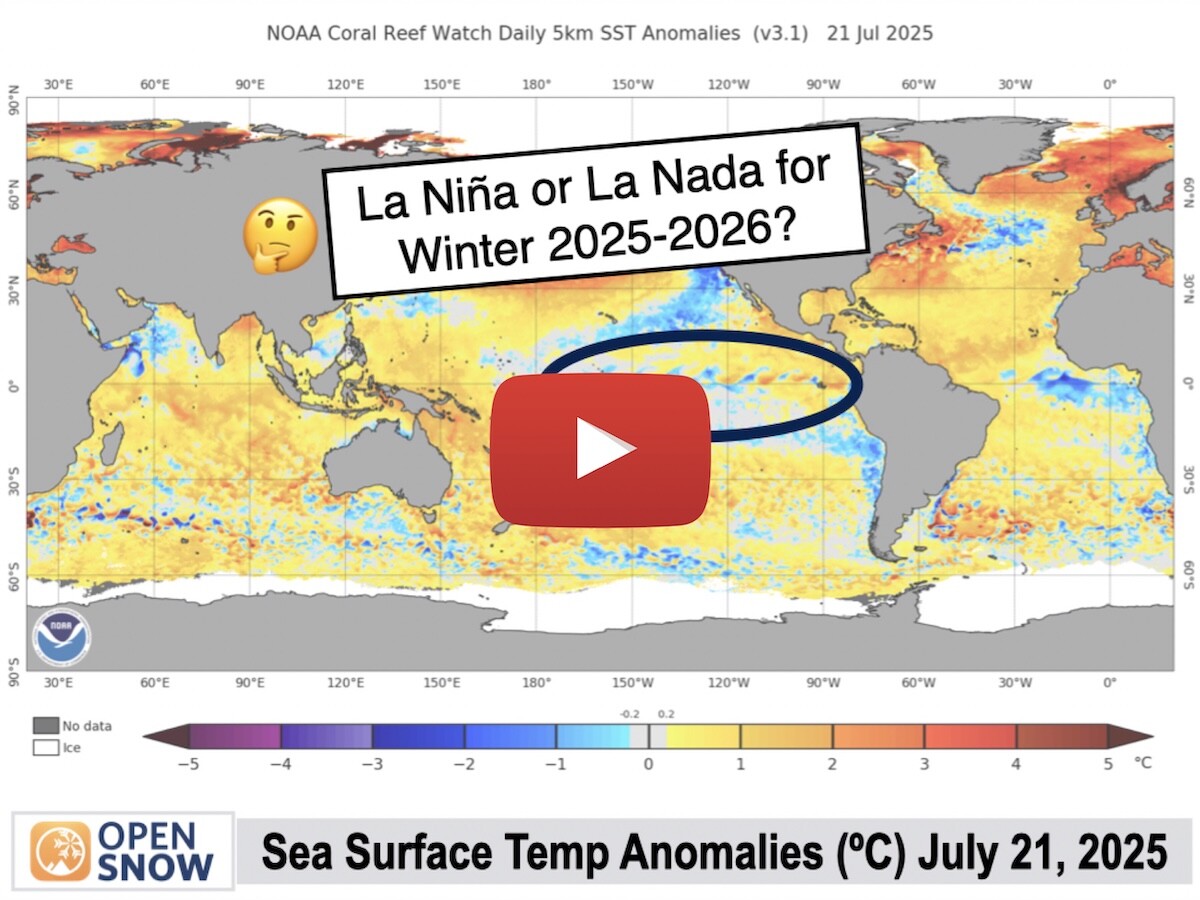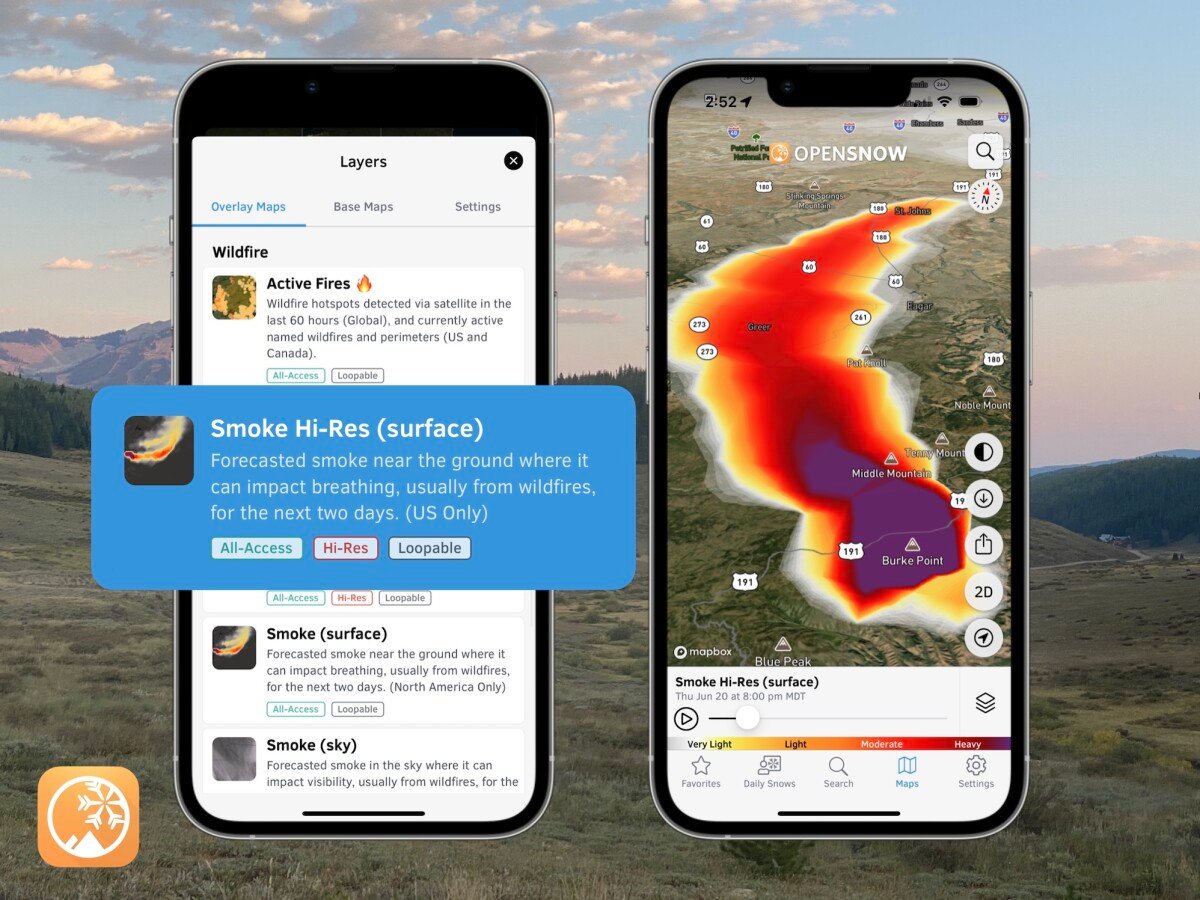Western US Daily Snow

By Alan Smith, Meteorologist Posted 3 years ago July 25, 2022
Flash flooding, fires, and heat
Summary
An intense monsoon pattern is currently in place across the Southwest, which will result in daily thunderstorms along with flash flooding potential, and the Sierra will see some of this action as well. Meanwhile, the PNW will experience a heatwave this week with well above average temps. Active fires in CA and ID are also leading to an uptick in smoke across much of the West.
Short Term Forecast
Forecast Highlights:
- Widespread thunderstorms with localized flash flooding across the Southwest, Southern Rockies, and to a lesser extent, the Sierra.
- Isolated to scattered thunderstorms near and east of the Continental Divide at times throughout the week.
- Uptick in thunderstorms/heavy rain for Eastern Colorado on Thursday and Friday.
- Increase in wildfire smoke across California, Oregon, and portions of the Great Basin and Northern Rockies.
- Heat wave for the Pacific Northwest from Monday to Friday.
Synopsis:
A tall and powerful ridge of high pressure is building along the West Coast with the center of high pressure located off the coast of BC. This will support an extended stretch of well above average temperatures across the Pacific Northwest this week. Meanwhile, an active monsoon remains in place over the Southwest with a daily threat of mountain thunderstorms and dry wash/slot canyon flash flooding expected for the foreseeable future.

Monsoon Update:
The Southwest experienced a significant uptick in monsoonal moisture over the weekend with numerous thunderstorms and localized flash flooding. A strong monsoon will persist over the upcoming week with signfiicant moisture in place across Arizona, Nevada, Southern Utah, and Southern Colorado, while moisture is also expanding westward into the Sierra Nevada Range.

North of the core monsoon region, moisture is also increasing across the Pacific Northwest, but strong high pressure will prevent any showers/thunderstorms early this week, while the higher moisture will instead make it feel more humid.
Near and east of the Continental Divide in Montana, a Canadian cold front is sliding in from the north, and upslope northeast winds behind the front will support daily rounds of isolated to scattered thunderstorms.
Over the next three days, the heaviest rainfall can be expected across Arizona, Southern/Central Nevada, Southern Utah, Southern Colorado, Northern/Western New Mexico, and the Central/Southern Sierra Nevada Range in California.

As of early Monday afternoon, a Flash Flood Watch is in effect for a large portion of Arizona and Southern Utah, while burn scars in New Mexico are also under a Flash Flood Watch.

Even outside of the Flash Flood Watch zones, a large portion of the Southwest is under a risk for excessive rainfall and localized flash flooding as well.

Lightning Outlook:
In addition to the heavy rain threat, lightning will be a significant threat across the mountainous regions of the Southwest U.S. this week.
On Monday, lightning activity will be highest around the Four Corners as well as the Southern Sierra Nevada Range. Thunderstorm and lightning activity will be more isolated near and east of the Divide in Montana, while the Black Hills of South Dakota will see more numerous storms.

On Tuesday, thunderstorm activity and lightning risks will be more widespread throughout the Southwest as well as the Sierra Nevada. Across the Rockies, thunderstorms will be numerous across Southern Utah and most of Colorado, while Northern Utah will largely miss out. Isolated thunderstorms can also be expected east of the Divide in Wyoming.

More of the same can be expected on Wednesday with numerous thunderstorms throughout the Southwest and Southern Rockies. Meanwhile, despite the ongoing heatwave, there is a chance we could see some dry thunderstorms across the Pacific Northwest, which would not be ideal in terms of fire danger.

Temperature Outlook:
A significant heatwave is expected across the Pacific Northwest this week with well-above-average temperatures. This will not be an extreme heatwave like what this region experienced last year, but it will still be very hot, especially east of the Cascades.
Meanwhile, temperatures will be cooler than average across Arizona and the Southwest thanks to the active monsoon, and areas east of the Continental Divide will also see a welcome break from the heat this week with cooler than average temperatures.

Fire and Smoke Outlook:
Unfortunately, smoke conditions are currently worsening across the West right now. The two biggest culprits are the Oak Fire in California and the Moose Fire in Idaho.
The Oak Fire started on Friday and has been exhibiting extreme fire behavior, growing to over 16,000 acres already. Air quality across the Sierra Nevada Range including Tahoe has deteriorated significantly over the past couple of days.

View → Smoke (Surface) Forecast Map (out to 2 days)
View → Air Quality Forecast Map (out to 5 days)
View → Current Air Quality Map
Could we see some help this week as monsoonal moisture reaches the Sierra Nevada Range? Maybe... Rainfall with summertime thunderstorms is usually hit or miss, especially in "fringe monsoon" regions such as California, so it will take some luck to get a heavy rain-producing storm that could help to reduce fire behavior.
Meanwhile, the Moose Fire continues to burn near the Idaho/Montana border outside of Salmon, Idaho and has grown to over 35,000 acres. A few smaller fires have recently started in this region as well.
Smoke will likely be an issue across the Sierra Nevada Range throughout the week with smoke expanding northward into Northern California and Oregon over the coming days as well.
Smoky or hazy conditions can also be expected at times this week across Nevada, Idaho, Montana, and Wyoming, with lighter smoke possible for Utah, Colorado, and Washington this week as well.
As far as fire weather goes, most of the West (Arizona/Four Corners excluded) will be in the "moderate" danger category this week.
Extended Forecast
Outlook for Thursday (7/28) to Sunday (7/31):
An active monsoon will continue through the end of the week. A backdoor cold front sliding down the eastern slopes of the Continental Divide will result in an uptick in thunderstorms along with heavy rainfall across the Front Range and Eastern Colorado on Thursday and Friday.
Monsoonal moisture will push northward into Wyoming with scattered thunderstorms developing on Thursday and Friday, while portions of Idaho and Western Montana will see isolated thunderstorms.

Heading into the weekend, high pressure will weaken over the West Coast and onshore flow from the Pacific will result in relief from the heat across the Pacific Northwest, at least west of the Cascades.
An active monsoon will continue across the Southwest and Southern Rockies through the weekend, while the Northern Rockies will see a drying trend compared to Thursday/Friday.
Outlook for Monday (8/1) to Monday (8/8):
The first week of August will feature a very active monsoon, which will continue to result in below-average temperatures across the Four Corners region. The Pacific Northwest will also see more seasonal temperatures, while California and the Northern and Eastern Rockies will see above average temperatures.

This is looking like a wet period for a large portion of the West with frequent thunderstorms along with wetting rains expected across Arizona, Utah, Western Colorado, and Nevada, while Wyoming and the Sierra Nevada Range will get in on the action as well. Drier conditions are anticipated east of the Divide in Colorado, however.

Thanks so much for reading! Next update on Wednesday (7/27).
ALAN SMITH
About Our Forecaster




